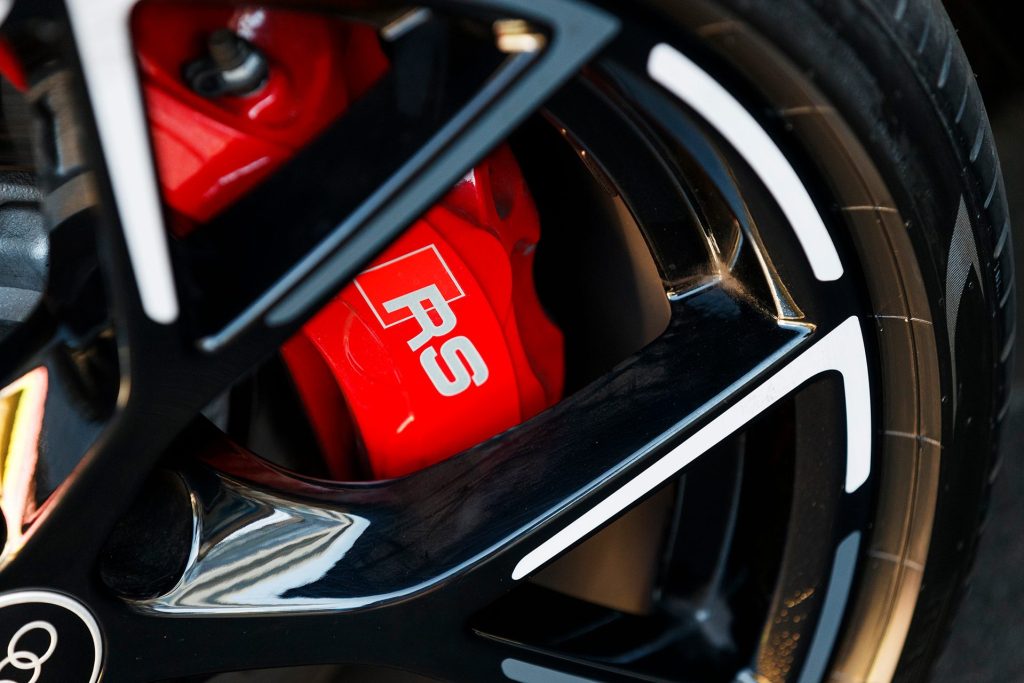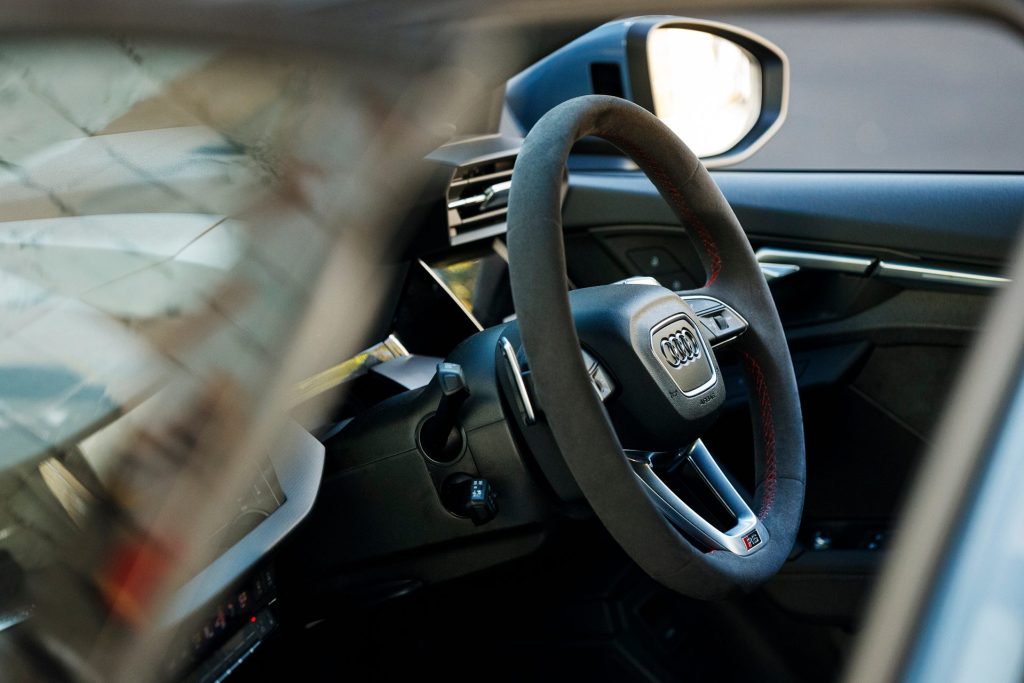They’re at it again, those two illustrious German houses of AMG and Audi Sport. Previously Audi was the first to release a hothatch that could run zero to 100 in under 4sec. AMG responded with an even stronger A 45 S, which rebagged the brag, signing off with a sprint time of 3.88sec.

However, that wasn’t going to last as there’s now a new iteration of the RS 3, the third generation. While shockingly it cannot match the A 45 S for power (294 vs 310kW), its multi-awarded 2.5-litre five-pot has received a torque bump, up 20Nm from 480 to 500Nm developed from 2250-5600rpm, level pegging with the AMG. But we all know that it’s not torque that determines the outcome of a drag race, right? Still, Audi reckons its new RS 3 is good for a 3.8sec 0-100 run. So somewhere along the way it has subtracted 0.3sec. How so? Let it launch harder, let it shift quicker, improve the variability of its front:rear torque split.

Without checking, we decided to try what seemed the appropriate drive mode, RS 3 Performance. No cigar here, the launch stodgy, the time way off the pace at 5.36sec. Which just goes to show how important getting off the line is for bragging rights. And launch control can often make a monumental difference. By shifting to Dynamic mode and nixing ESP totally, our very next run netted a time of 3.82sec, right on Audi’s money. We undertook one more and got 3.67sec and felt as if we’d probably not improve on that, given the iffy surface.

Holy smokes though, that’s awfully quick for a compact five-door hot hatch. Go to hot mix and it might run under 3.5sec. Not convinced? Well, we gave it one try on hot mix and used the car’s own 0-100 tracker. Guess what? It signed off at precisely 3.5sec.

Not so long ago none of these little upstarts would crack 4.0sec. We reckon the tranny has a lot to do with it in this case; the dual clutchers can be lightning quick. Audi puts it down to peak power arriving slightly earlier, from 5600rpm. Its impressive sprint time almost overshadows how quickly it accumulates speed from 80-120. While 2.52sec is right up there with the best of the hot littl’uns, it’s not any faster than before. The A 45 S still holds sway at 2.44sec. Audi reckons the top speed of the RS 3 is 290km/h (180mph) putting it at the top of the heap. Not here though; the delimiting is part of a carbon ceramic brake upgrade package that isn’t available so sorry track addicts; steel brakes it is then. Good job they’re stunners, brimming with bite.



Back in the real world
Performance testing only tells what it’s like given the lead foot treatment. After pick-up we took to the rough and tumble road that’s known as SH16, connecting West Auckland to Wellsford. This is a real test of ride refinement. This aced it; modern hyper-hatches are no longer the bump jumping things they used to be. Stiffer chassis builds allow suspension set-ups to be more compliant. And adaptive damping means you can obtain the best results over a variety of surfaces. This even has a Comfort mode that’s not ironically named. It’s nothing like as hard-edged as I thought it might have been over this difficult section of road. We tried Comfort, Auto and Dynamic settings, all three being pretty agreeable, a surprise given this runs 265/30 ZR19s up front, 245/35ZR19s rear. But it was Comfort we kept returning to. True, the engine vim matches the easy-going set up of the suspension but with a quick pull of the wee shift-by-wire gear lever, the drivetrain is suddenly energised into its Sport setting. And once revs hit 2500-3000, the turbo is most definitely on the case. Hit it hard for a passing move and there’s a second’s hesitation, but then it’s spooled and gone. Does it sound good? Surely, with that five-pot thrum but more of it would be nice, or perhaps another hearing check is due. We noted pretty decent fuel use figures too, in the 9s when taking things at a bit of a clip. The average is a claimed 8.8L/00km so that seems rather impressive.

Naturally, if the standard settings don’t work, you can mix and match your own in the Individual mode, and if you take this to the track there’s the RS Performance setting, optimised for circuit work. The car has the facility to clock your laps too, while performance gauges, lateral Gs, boost and power help with diagnosing your deficiencies!

And then of course there’s the RS Rear setting which we explored at the Mt Smart drift track facility. Such an excellent morning out. Between classes at Hampton Downs track day sessions, be sure to ask for access to the skid pan, switch on the sprinklers for a bit and check out your talent for circle work. If you’re a novice it’s best to switch ESP to the intermediate setting first, as a bit of a safety net, and once you’re happy with that, switch it out completely and go crazy. It’s about the best fun you can have without your partner involved, if you get my drift.

More neutral cornering stance
As to how this gets around corners, well we already had an inkling from the drift session and you’d expect something of an improvement with the installation of the RS torque splitter at the rear. There’s a clutch pack splitting torque north and south but RS 3 also features an electronically controlled clutch pack on either rear drive shaft. In right-hand corners, the torque splitter assigns more drive to the left rear wheel, helping to propel the car through the corner, limiting understeer, and it’s the opposite for left-hand corners. Expect improved agility and stability in corners, check, sharper turn in as well, and you can also hit the gas earlier on the exit, like way earlier.

Audi has kind of proven it for themselves that it works, lowering the time for a car of its class to complete a circuit of the Nurburgring by 4.6 seconds (7min 41sec, wresting the title from the Megane Trophy RS). In RS Rear mode, all power is sent to one wheel to kick out the rear and it’s up to the driver to hold it there with deft adjustments of steering and throttle.

But it’s how this corners that is a marked improvement on its predecessor, much of it due to the torque splitter, though an increase in front track of 33mm doesn’t hurt either. We mentioned in 2018 that you are never going to get the RS 3 to tighten its line through a corner by adding gas. True back then but not any longer. On the photographic shoot this made it through one of our right angle corners about as quickly as anything ever has, and all without great drama. Indeed it tightens the line as you add gas early, but then it also does that by going in hot and lifting off, as did the last one. During regular driving it’s just as apparent that the RS 3 now steers in remarkably neutral fashion. If you’re clumsy or overset your entry speed it will squeal and run ever so slightly wide of the line but the extra rubber up front compared with at the rear helps alleviate that tendency. And being AWD its general levels of mechanical grip are simply heroic.

What’s it got?
More to the point, what has it not got? And that would be a panoramic sunroof ($3000), matrix LED headlights and dynamic taillights ($2000), head-up display (should be standard but it’s $2300) and a B&O sound system upgrade for $1500. There are also a whole host of $2000 interior design packages in red and green, and a black-out exterior package. Split folding takes the smallish 282L hatch to greater heights.



Has it got what it takes to best the AMG A 45 S? That’s now too close to call. If you’re a five-pot fan, probably. Whatever, you can be assured that these ICE mini-monsters are the last of their line. Expect their replacements to be hyper-hybrids.
| Model | Audi RS 3 Sportback |
| Price | $112,500 |
| Clean Car Discount | Fee + $1,495 |
| Engine | 2480cc, IL5, T, DI |
| Power/Torque | 294kW/500Nm |
| Drivetrain | 7-speed twin clutch, AWD |
| Fuel Use | 9.5L/100km |
| C02 Output | 216g/km |
| 0-100km/h | 3.67sec |
| 80-120km/h | 2.52sec (71.94m) |
| 100-0km/h | 34.22m |
| Stability systems | ABS, ESP, TV |
| Safety | AEB, ACC, BSM, LDW, RCTA, ALK, AHB |
| Luggage Capacity | 282-1104L |
| Tow rating | Not rated to tow |
| Service intervals | 24 months/30,000km |
| Scheduled servicing | 3 years/150,000km |
| Warranty | 5 years/unlimited km |
| ANCAP rating | Not yet rated |
| Weight | 1570kg (claimed) |



